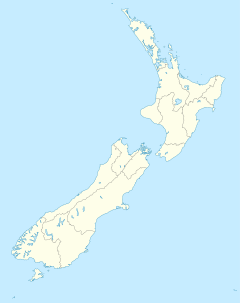Mount Cook National Park (New Zealand)
| Mount Cook National Park | ||
|---|---|---|
| Mount Cook National Park | ||
|
|
||
| Location: | Canterbury , New Zealand | |
| Specialty: | 40% glaciated | |
| Surface: | 706.96 km² | |
| Founding: | 1953 | |
| Address: | Mount Cook National Park Aoraki / Mount Cook PO Box 5 |
|
| Tasman Valley | ||
| Flora of Mount Cook National Park | ||
The 707 km² Mount Cook National Park , Māori Aoraki is located on the South Island of New Zealand . It was established in 1953 and comprises a high alpine mountain landscape that borders the Westland National Park . Together with the Westland, Fiordland and Mount Aspiring National Park , Mount Cook National Park forms the so-called Te Wahipounamu World Heritage Area . The national park is named after the Aoraki / Mount Cook , with 3724 m the highest mountain in the New Zealand Alps . Since 1990, the area is part of the World Heritage of UNESCO . Since 2012 it has also been designated as a light reserve as the Aoraki / Mackenzie International Dark Sky Reserve .
The starting point for numerous leisure activities (hiking, mountaineering, skiing, sightseeing flights) is Aoraki / Mount Cook , which also offers overnight accommodation. In the park itself there are 17 refuges for mountain hikers.
Flora and fauna
flora
There is hardly any forest in the Mount Cook National Park, which is a consequence of both natural factors (climate, steepness, lack of suitable soils) and human influences (Maori fire, later the Europeans; damage from introduced animals such as deer, chamois, springbok, Rabbits and hares) is. Nevertheless, there are over 550 species of alpine flora (excluding mosses, lichens and algae), of which 135 are endemic .
The most noticeable include:
- Yellow buttercup ( Yellow Buttercup , Ranunculus acraeus )
- Mountain Daisy ( Mountain Daisy , Celmisia verbascifolia )
- Golden speargrass ( Golden Spaniard , Aciphylla aurea )
- Giant Mountain Buttercup ( Giant Mountain Buttercup , Ranunculus lyallii )
- Sheep Carpet ( Vegetable Sheep , Raoulia eximia )
- Snow Gentian ( Snow Gentian , Gentiana bellidifolia )
- South Island Edelweiss ( South Island Edelweiss , Leucogenes grandiceps )
The multi-colored lupins in the valley are particularly eye-catching, although they were not originally native here.
Birds
- The rock slip ( Rock Wren or Piwauwau , Xenicus gilviventris) is also endemic here, after it was already exterminated on the North Island. This approximately 10 cm long, yellow-green (males) or olive-brown (females) colored passerine bird is a bad flyer and rarely leaves the high alpine zone.
- The leave of raptors Swamp Harrier ( Australian Harrier or Kahu , Circus approximans) of and, less frequently, Maori Falcon ( New Zealand Falcon or Karearea , Falco novaeseelandiae) observed.
- The kea (mountain parrot, Nestor notabilis) lives mostly near the tree line, but can also be observed at great heights. It is endemic to the New Zealand Southern Alps. In the 20th century the number of these birds fell sharply through hunting; The reason for this was the (arguably greatly exaggerated) fact that they occasionally attack the farmers' sheep. The kea is now strictly protected.
- Despite the almost complete absence of forest, some forest birds can be observed in Mount Cook National Park, including the green hatch ( Riflemen , Acanthisitta chloris), the bell-honeydew ( Bellbird , Anthornis melanura), the Maori flycatcher ( Tomtit , Petroica macrocephala), the gray-backed bird. Spectacled bird ( Silvereye , Zosterops lateralis) and - more rarely - the Tui (Prosthemadera novaeseelandiae).
- The numerous rivers in the National Park are home to many wading birds , including Schiefschnabel- plover ( Wrybill , Anarhynchus frontal), black-fronted tern ( Black-fronted Tern , Sterna albostriata), double-banded plover ( Banded Dotterel , Charadrius bicinctus), South Island Oystercatcher ( South Iceland pied oystercatcher , Haematopus finschi) and stilt ( pied stilt , Himantopus himantopus). The extremely rare black stilt ( Black Stilt , Himantopus novaezelandiae) can still be found here in a few specimens.
Among other ducks and geese especially is paradise shelduck ( Paradise Shelduck , Tadorna variegata) striking.
insects
There are numerous endemic species of butterflies, grasshoppers, and other insects, as well as spiders. The New Zealand weta ( Alpine Weta , Hemideina maori), which is still native at altitudes above 3000 m, is particularly noteworthy because of its frost tolerance .
Web links
- Department of Conservation: Aoraki / Mount Cook National Park (Engl.)
- Entry on the UNESCO World Heritage Center website ( English and French ).
Individual evidence
- ↑ Mount Cook: New Zealand's highest mountain shrunk 30 meters. In: Spiegel Online , January 16, 2014




